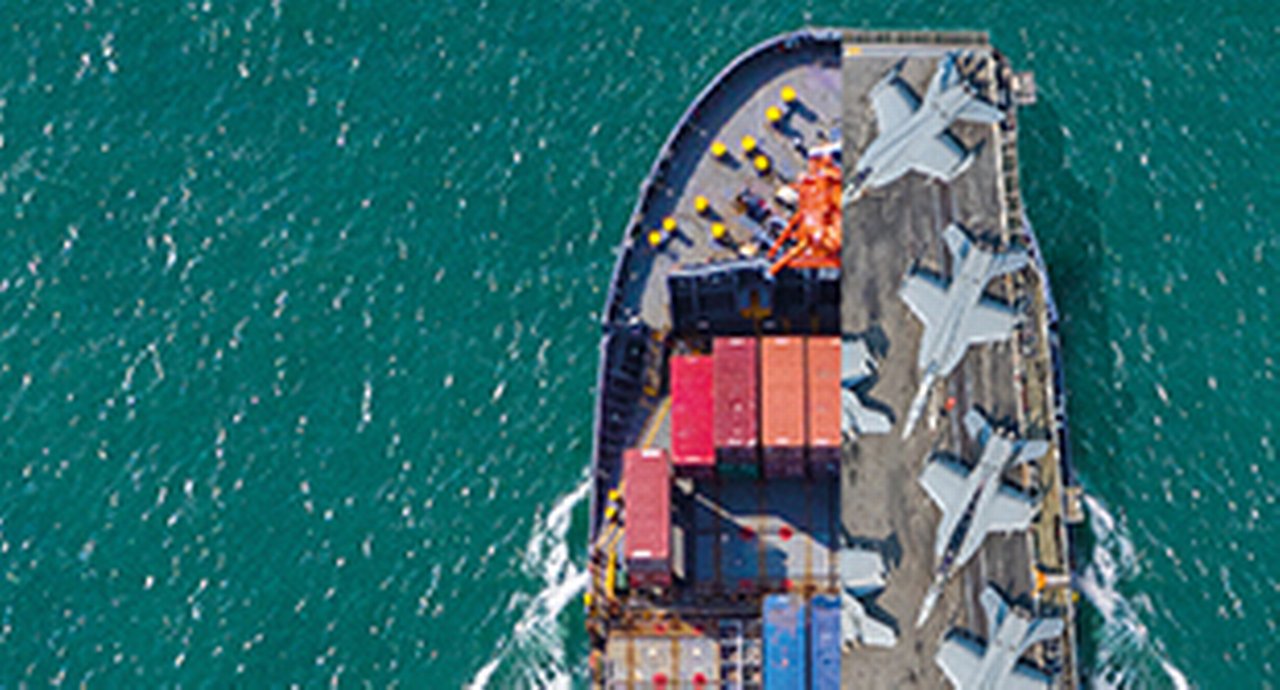March 2020
How will India’s meet its US$5trn GDP target in the next five years? And what role will financiers, government reform and technology have in making this happen? Clarissa Dann reports on GTR’s one-day conference in Mumbai
When 363 delegates from 172 organisations and 13 countries descended on the Taj Land’s End hotel in Mumbai on 10 February 2020, despite the widespread cancellations from Coronavirus-struck countries it still represented a record turn-out for trade finance media house GTR.
Growth surge
Why? India is poised for a surge of GDP growth; that was the message from keynote opening speaker Shailesh Haribhakti, Mumbai-based independent non-executive director of various large Indian corporates (including Ambuja Cement) and chartered accountant. And growth brings opportunities – particularly for investors and lenders.
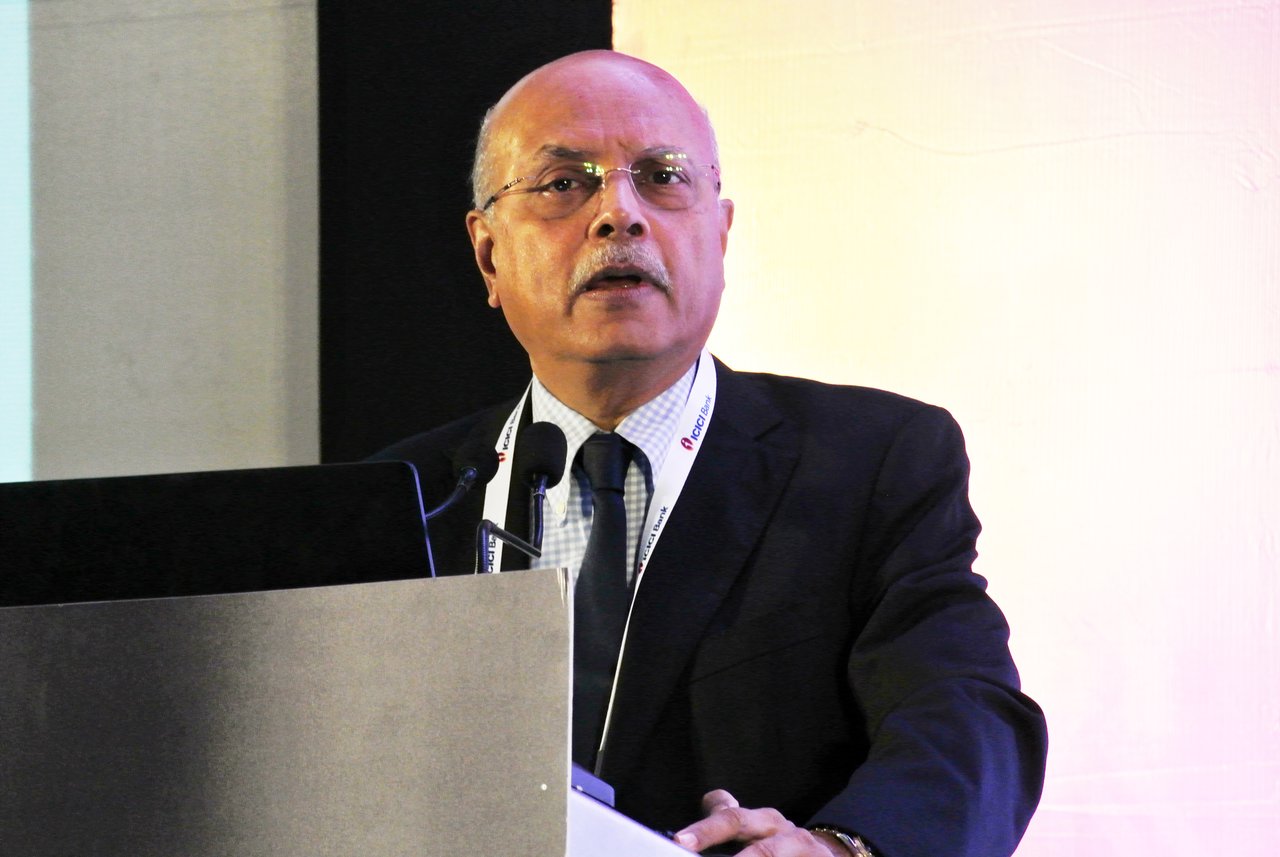
Keynote speaker Shailesh Haribhakti opens the conference on why 2020 will be a year of reform and liberation
“2020 will be a year of reform, liberation and innovation,” he predicted, adding this was clear when the finance minister, Nirmala Sitharaman tabled her Union Budget on 1 February. Referring to India’s annual economic survey, enshrining the country’s ambition to become a US$5trn economy by 2025, she had projected the economy would grow by 6% to 6.5% in the new fiscal year commencing 1 April 2020.
2020
“The jump up to 6.5% GDP growth should be possible,” said Haribhakti (acknowledging the Reserve Bank of India’s projection of 6% in its 6th February Monetary Policy Statement) because of two “twin engines of growth. These are, he explained, the 10% growth in demand for cement – up from between 0% and 5% in the past year –and the surge of credit flow both taking the economy forward.
Reinvigorating exports
To have a chance of reaching these growth targets, India needs to up its trade game. However, reflected Haribhakti, there was a huge way to go before exports could rise back to their former glory days of the early 18th century when they accounted for nearly 25% of all world trade. Right now, India’s share is just 1.67%, brought about by “decades of insularity” following independence in 1947. He expressed his disappointment, noting that current mindsets do not support multilateralism and tariffs abound.
Measures that would help move things in the right direction include more support for exporters from India’s export credit agency, Exim Bank India (that recently announced a raft of recapitalisation measures to expand its capacity), and increasing the efficiency of Indian ports.
Cost pressures
The whole world of creating fresh documents in every stage of the value chain needs to be taken away”
“The whole world of creating fresh documents in every stage of the value chain needs to be taken away,” Haribhakti declared. “It has to be automated so that whatever needs to be done to discharge goods from ships to onward transport and into the economy is done with the efficiency it needs,” he added, with everyone in the room nodding in agreement.
India has made good progress with containerisation infrastructure, he said so that trucks can now haul full containers of goods to where they need to be distributed. As for the country’s opting out of the Regional Comprehensive Economic Partnership (RCEP) in November 2019 – after seven years of negotiations on the grounds of inadequate safeguards to protect Indian farmers – Haribhakti believes there is a strong case for India getting back into RCEP. Why? Manufactured goods once exported from China are now being produced in ASEAN country locations If India does not have free trade agreements with those countries “then we will be stuck with high import costs [and] that is the reason why I am making the case for rejoining the RCEP.”

Henny Sender (FT) and Graham Bright (Euro Exim Bank) discuss India’s relationship with the Regional Comprehensive Economic Partnership
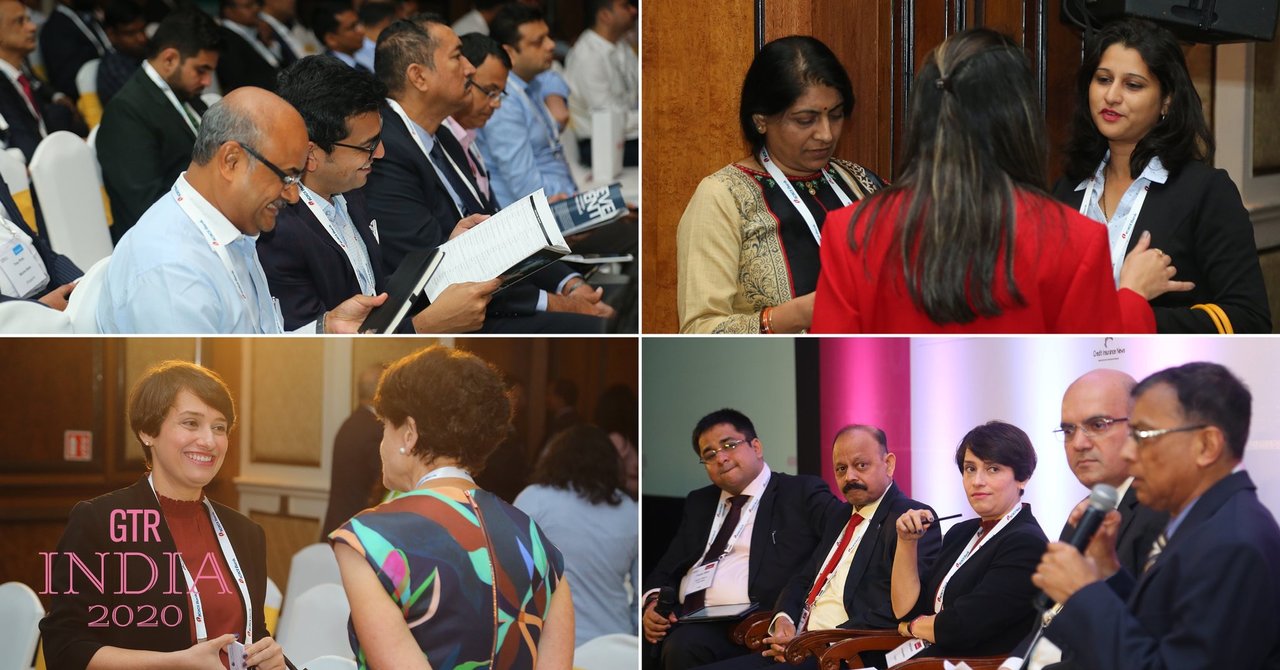
Delegates and speakers at GTR India 2020 (thanks to GTR for the photo)
Supply chain opportunities
With investment into India’s supply chain infrastructure gaining momentum from five years of significant investment on roads, railways, water, irrigation and urban infrastructure, the next five years, according to Reuters reports on Sitharaman’s announcements, will see a series of projects as part of a plan to invest INR1trn (US$1.39bn) in the infrastructure sector.
This capital injection is not before time. Mumbai alone has a population of 25 million but getting to work in the city is literally a matter of life and death – most conference delegates had travelled to the event in gridlocked traffic by minicab. It’s a mode of transport most city workers use, despite average speeds rarely exceeding 8km an hour. In 2018 although the number of deaths on the suburban railway system had reduced by 10% from the previous year it was still 2,734 ; overcrowding and trespassing on tracks being the main factors. With India’s labour force being such an important element of the country’s means of achieving the US$5trn growth target, giving it safer commuting is a good place to start.
Moderated by Mayank Gupta, Head of Trade at Citibank, a panel session exploring India’s supply chain opportunities noted that such increased government spending, along with the liberalisation of foreign direct investment (FDI) rules has helped spur growth as the country aspires to become a global manufacturing powerhouse. But is it doing enough to attract global supply chains to set up shop there?
Manpreet Kaur, Founder and CEO of Vivantaa Capital pointed out that a study of India’s mobile and electronics industry segment offered grounds for optimism. In 2012−13 the industry was 100% import based. “Now we are contributing US$20bn in terms of mobiles manufactured locally,” she said. It was important that the sector matched international standards for its exports to arrive at a level of quality such that India “will be the top manufacturer in the world”. Another panellist observed that while the Coronavirus was “very regrettable” it did present certain opportunities for Indian manufacturing a
By July 2019, India’s goods and services tax reform (GST) had been in place for two years and e-invoicing becomes mandatory as at 1 April 2020 in a bid to improve transactional transparency and reduce tax evasion. In an e-invoicing environment, the moment an invoice is created, it has to be uploaded onto the Goods and Services Tax Network (GSTN) portal for pre-validation and assignment of an invoice reference number. Once the invoice reference number (IRN) is issued, the tax invoice is shared with the recipient.
GST and e-invoicing have brought opportunities, noted the panel and India has risen 14 places to #63 in the World Bank’s Ease of Doing Business ranking on the back of these and other economic reforms.
Kaur explained that when a truck travels from Mumbai to a North-Eastern state in Assam it crosses eight states. “The truck has to stop at each boundary at each state, clear the documentation, pay the taxes and absorb a waiting time of one to three days.” Pre-GST that typically led to a loss of 20 working days and increased the costs. In addition the opacity of the old taxation system led to arbitrage between the states, with the same product costing more in one state than another.
With the implementation of GST, “everyone knows where the goods are moving and everyone can pre-calculate the tax,” she said. In Kaur’s view this was “a great reform” and has given much transparency to supply chains when trading with India.
She also made the point that India is one of the largest producers of fruit and vegetables, but around 30% to 40% of the crop gets damaged in transit. “Infrastructure needs to support our agriculture with cold storage and at the point of origination, “she said.
“Infrastructure needs to support our agriculture with cold storage and at the point of origination“
India’s Smart Cities
Launched in 2015 India’s Smart Cities Mission, administered by the government’s Ministry of Housing and Urban Affairs, aims to promote cities that provide core infrastructure (such as adequate water and power supplies, sanitation and waste management, urban mobility and public transport) and “give a decent quality of life to its citizens, a clean and sustainable environment” acting as “a beacon to other inspiring cities.”
State governments nominated cities as participants and the administrative bodies of those cities were then asked to submit smart city plans for urban renewal. One hundred cities were chosen to receive funding to implement their plans and the deadline for project completion was set between 2019 and 2023. In September 2019, the 10,000 acre Aurangabad Industrial City was inaugurated as the first “smart city”
James Binns, Global Head of Trade and Working Capital at Barclays (formerly at Deutsche Bank), together with panellists from Siemens and Honeywell Automation India, discussed the potential of the US$30bn Smart City Mission for turning India into “the world’s largest construction market”.
Beyond the government definition, what does “smart city” really mean? asked Binns. The answer, agreed the panel was a city that improved the quality of life for its citizens and promoting efficiency. “It’s where everything will be connected to everything else, working in tandem to seamlessly deliver solutions and services,” they decided, while acknowledging that the term “smart cities” is open to various interpretations.
In addition, the scheme has promoted cooperation between the EU and India – a Joint Action Plan was announced in New Delhi on 19 September 2019 to step this up, stating that the next phase of implementation would see further cooperation between the two regions. The European Investment Bank aims to invest €1bn in urban transport to follow existing metro projects of €1.6bn in India. In 2016, the Obama administration in the US signed MoUs to develop three smart cities in Allahabad, Ajmer and Visakhapatnam providing project planning, infrastructure development, feasibility and capacity building.
Both the panellists confirmed that their organisations (one German and one US) were working with Indian smart cities and how important it was that solutions put in place could be maintained in the long terms and were sustainable. So “it is about the right contracts with the right vendors.”
However, they challenged banks to look afresh at new models of finance. “You see pay-as- you-go and pay-as-you-save models in the commercial space, but these are emerging areas banks are not making headway in,” said one panellist. “This has to change, as the world is recalibrating,” said the other.
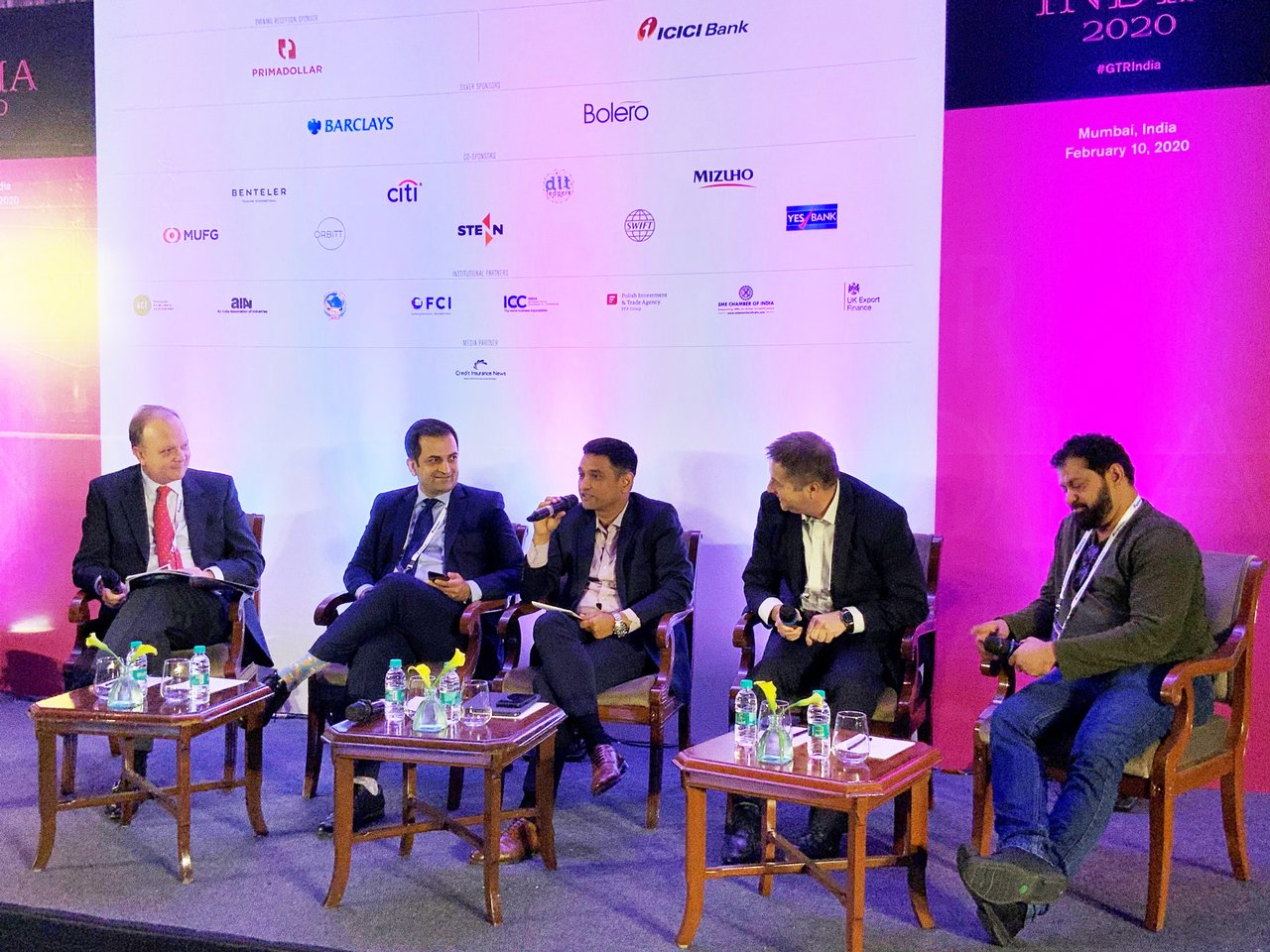
Left to right: Dominic Broom (LIBF); Rohit Narayana (MUFG), Anand Jha (Deutsche Bank); Tim Nicolle (PrimaDollar); and Samir Jeji (DLT Ledgers)
Financing Indian trade
“What does the future hold for trade finance?” asked Dominic Broom, Executive Consultant, The London Institute of Banking and Finance. He was moderator for a panel comprising Deutsche Bank’s Anand Jha, Head of Trade Finance and Lending, India, Rohit Narayana, Head of Trade Sales MUFG Bank India, Tim Nicolle, CEO PrimaDollar and Samir Jeji, CEO DLT Ledgers.
An abundance in liquidity, thanks to the loosening of central bank strings in the past decade, has created a spike in the Indian banking system of INR3.6trn (US$48bn), signalling a mismatch of supply and demand, noted the panel. The larger corporates with an acceptable risk profile to banks are sourcing liquidity from the capital markets, but the smaller businesses that want the liquidity are less attractive to lenders.
“Are banks doing the wrong things with their liquidity?” queried Broom. Deutsche Bank’s Jha said it would “take time to get the structural issues in the country sorted out”, noting that many of the public sector banks control around 65% of India’s corporate debt. While private banks are trying to fill the gap it won’t happen overnight. PrimaDollar’s Nicolle insisted that “if you have a financeable transaction, someone will finance it”, adding “India has its unicorns and success stories and we are delighted to be here.” Adding a dash of controversy, he suggested that technology (like blockchain) might provide improved transparency and better insights, it does not materially reduce risk – so we should not expect technology by itself to reduce cost of financing in global trade.
“Every bank is an extended arm of the regulator in the country where they operate and that is how you have to understand the whole ecosystem,” reflected Jha. He who maintained that everyone was doing their best to make trade finance as accessible as possible in their countries of operation. And as for the trade finance gap, suppliers of large MNC buyers do at least benefit from the buyer credit rating, which is why, “a lot of credit comfort lies in the supply chain”.
The problem, concluded Narayanan is that while fewer than 0.33% of smaller suppliers default, trade finance is simply not trickling down to them. Predictably, PrimaDollar pointed out that the way they do business from the position of both ends of the trade, makes life a lot more straightforward. “The challenge is doing joined-up thinking across borders. Politicians and regulators want bank’s deposits to be used to finance the bank’s customers, not factories in far-off countries. The non- banking world is the oil that can grease the machinery to allow trade to work efficiently,” he said.
To summarise, simplicity, innovation and standardisation need to work side by side. Non-banks need to build on their partnerships with banks if the trade finance gap is to be reduced, said Broom.
Outlook
After a packed day, there was much to be optimistic about in terms of the many positives India could unleash. In a follow-up discussion back at the Deutsche Bank offices in Bandra Kurla Complex, Country Head Kaushik Shaparia said that India’s large young population who are raring to go, good natural resources, the country’s spirit of entrepreneurship, and long-term enabling work from the government have all had a great impact on the economy. “If the government even does a third of the promised US$1.4trn infrastructure investment over the next five years, this will really help. And the opening up of FDI will give more opportunity for overseas investors,” he said.
Former Indian leader Mahatma Ghandi once said “man’s upward progress means ever increasing difficulty, which is to be welcomed,” But it would appear that India’s upward progress means the reverse – more simplicity.
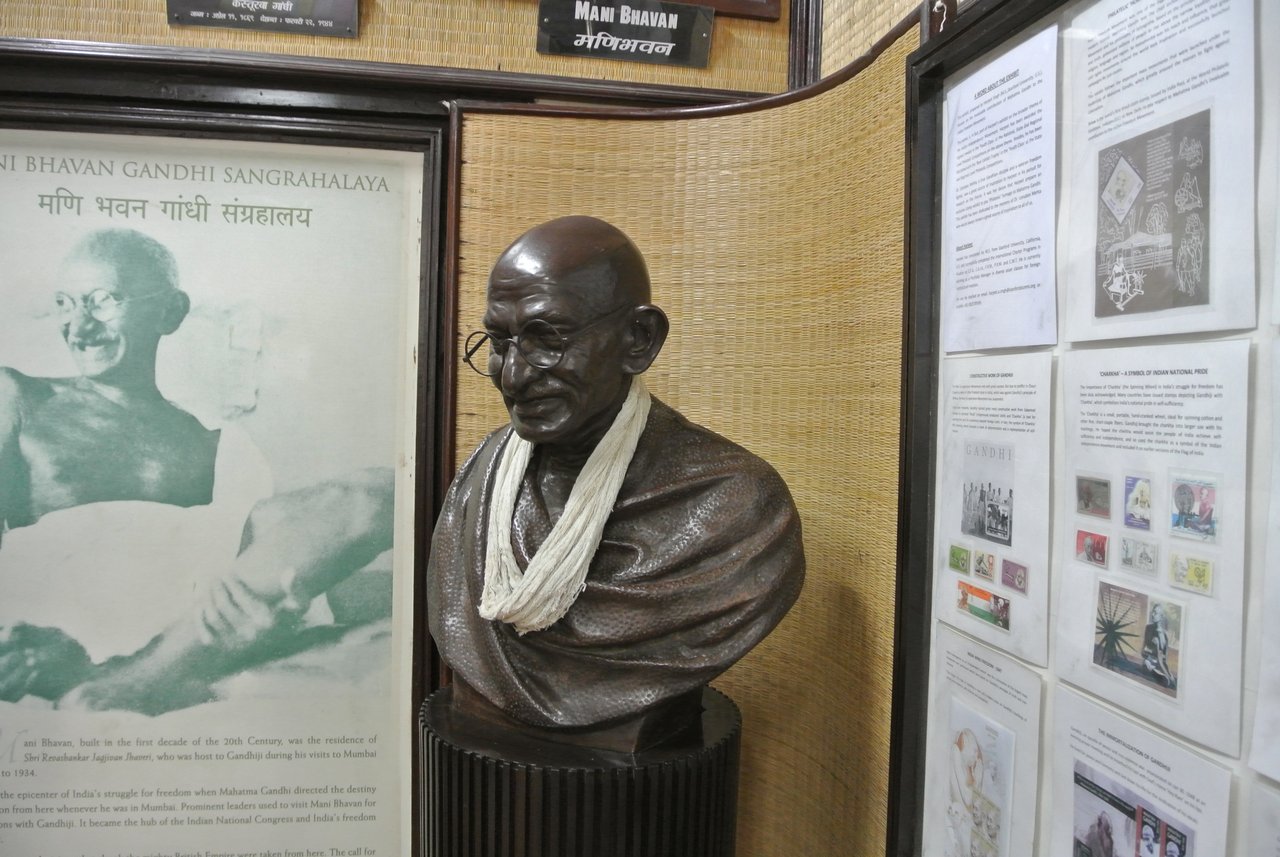
A bronze of Mahatma Ghandi greets visitors to his former Mumbai home, Mani Bhavan Ghandi Sangahalaya
GTR India 2020 was held in Mumbai on 10 February 2020
Go to Corporate Bank EXPLORE MORE
Find out more about products and services
Go to Corporate Bank Go to Corporate BankStay up-to-date with
Sign-up flow newsbites
Choose your preferred banking topics and we will send you updated emails based on your selection
Sign-up Sign-upSubscribe Subscribe to our magazine
flow magazine is published annually and can be read online and delivered to your door in print
You might be interested in
Trade finance and lending {icon-book}
Many rivers to cross Many rivers to cross
As China’s role on the global stage expands, Bank of China’s Yunfei Liu talks to flow about the foundations needed to build bridges in international trade
Trade finance and lending {icon-book}
Trade and the virus Trade and the virus
As Covid-19 dislocates supply chains in Southeast Asia, corporates are turning to supply chain finance to maintain their liquidity. Chito Santiago of the Asset talks to Zandy Ip and Daniel Tan about how anchor buyers are supporting their suppliers
Trade finance and lending {icon-book}
Merchants of peace Merchants of peace
Celebrating a century of keeping the peace through supporting international trade, International Chamber of Commerce has a new Finance for Development Hub for tackling modern impediments to financial inclusion and trade facilitation. David Meynell reports


